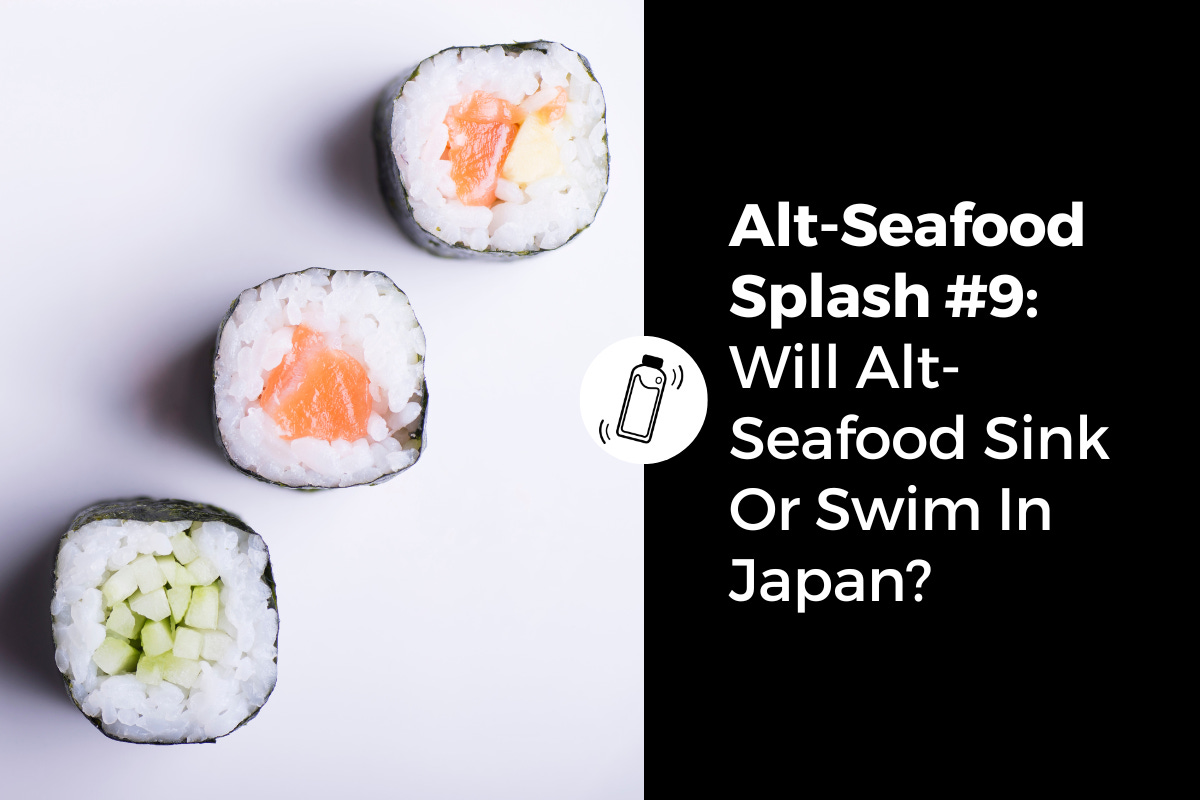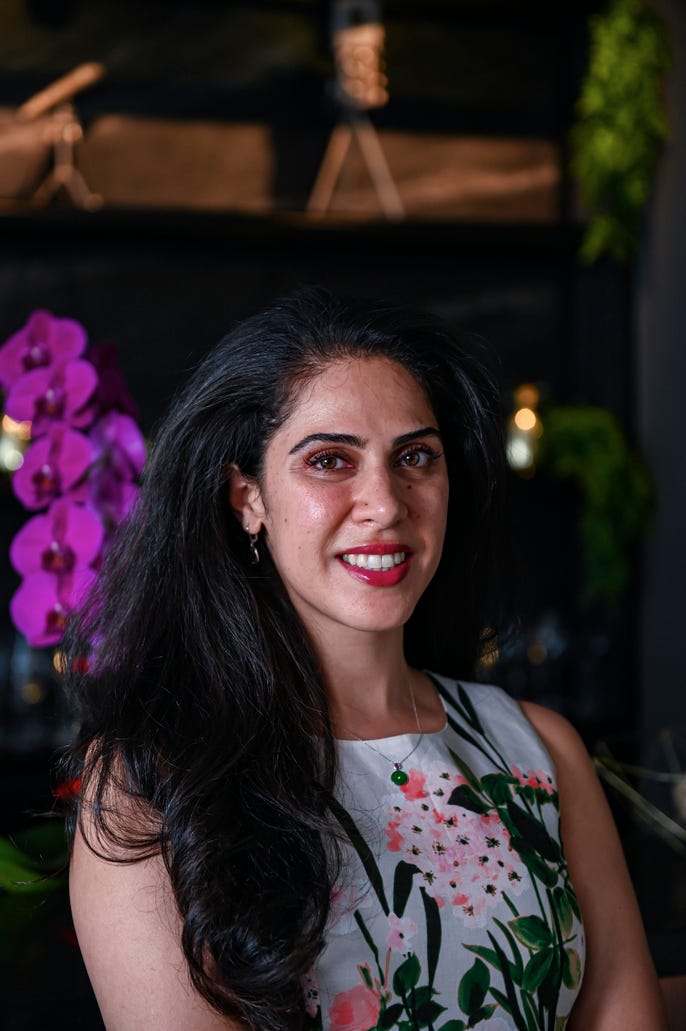Alt-Seafood Splash #9 – Will Alt-Seafood Sink Or Swim In Japan?
Happy Tuesday Market Shakers. Welcome to our final post in the alternative seafood series. Thank you for staying with us as we explored all the delicious offerings on the alt-seas! Today we tie everything together, and hear some investor insights from Dr. Dalal AlGhawas, Director of Programming at Big Idea Ventures.

In today’s post:
- Alt-seafood is still spawning as an industry
- Alt-seafood has oceans of potential
- Japan will be a niche market
- Japan’s greatest challenge is also its greatest opportunity
- We must educate consumers about the dangers facing our ocean
- Could cultivated seafood be key?
Alt-seafood is still spawning as an industry
Wherever you are in the world, alt-seafood is an emerging category, not just in Japan. It lags behind meat and dairy alternatives which have been the focus of the F&B industry to date. Comparing investment data for alt-meat and alt-seafood shows that it’s only in the last 5 years that seafood has started to emerge as a category. According to data from Statista, other alternative proteins were receiving similar levels of investment in 2010 as faux-fish did in 2018.
There are several reasons why alternative seafood has been slow to take off. Terrestrial agriculture has a much higher carbon footprint, so producing alternatives to meat and dairy has been prioritized. Though it can contribute to reducing greenhouse gasses, alt-seafood is seen more as a solution to conserve ocean resources and reduce overfishing.
Advances in aquaculture are also being prioritized by nations around the world as the solution to what ails our oceans. The rapidly growing practice has been revealed to have downsides, however, including the spread of disease, environmental pollution, and high water usage.
Alternative seafood is also comparatively challenging to make compared to alt-meat. There are hundreds of species of seafood to replicate. Each has different taste and texture profiles. Currently, companies are working to nail the taste and texture of a few key varieties, such as salmon, tuna and shrimp.
Yet, replicating the flaky, delicate texture of seafood cannot be done with the same set of ingredients and processes used for meat. Instead, companies venturing into alt-seafood must start from zero-base. This underscores another reason why alt-seafood remains niche.
Quite simply: it’s new. There is a lack of research and development in the field. Most product development and discoveries are proprietory too, so new insights are not always shared within the industry. This is particularly challenging for cutting-edge products such as cultivated seafood according to Dr. Dalal AlGhawas, agri-food businesswoman and Director of Programming for Big Idea Ventures (BIV).

When you look at cultivated seafood cell lines we don’t have pre-existing research and technology on how to grow them successfully. We haven’t used them as extensively in medical sciences as terrestrial animals either. So a lot of intellectual property belongs to startups that are working with seafood cell lines. This is great for them because they can generate patents, but the industry naturally grows at a slower rate as players discover insights on their own.
Alt-seafood has oceans of potential
If alt-seafood can capture the same percentage of overall seafood sales as alternative meat did for meat, it’s an opportunity worth hundreds of millions of dollars.
Players are starting to catch on to this whitespace opportunity. The plant-based seafood market alone is predicted to reach a value of $1.3 billion (CAGR 28%) by 2030. But it’s not just treasure attracting startups to the alt-seas. Growing concerns about our ocean ecosystems are bringing more and more ethically minded businesses and consumers into the alternative seafood space.
Given the potential, players are eager to collaborate and grow the market together. This was a sentiment shared by all the experts we interviewed in our alt-seafood series. Be it large companies supporting startups by co-manufacturing their products, or innovators developing tech that will turbo-charge growth in the category, it’s promising to see the alt-seafood world working together.
Like what you’re reading?
Subscribe
Supporting the rush of activity around faux-fish is interest from investors. In 2021 investment in alternative seafood increased by 92% from 2020. According to Dr. AlGhawas, the opportunities are vast.
Within the category of alternative seafood, there are so many species to work with, so many different verticals. There’s a lot of room for localization in terms of flavours and uses also. Avant Meats in Hong Kong for example has crossed over into the cruelty-free cosmetics space. As an investor, the range of opportunities we can support companies to take advantage of is really exciting.
Innovators are increasingly looking to Asia as a promising market for alternative seafood. It’s the region with the highest conventional seafood consumption after all. Depleting fish stocks also spells disaster for the areas that rely on seafood as their main source of protein.
So where does Japan fit into the picture, and is its future swimming with faux fish?
Japan will be a niche market
Several weeks of research and writing on the subject have confirmed our initial hypothesis; that alternative seafood will be a niche market in Japan for the foreseeable future.
A chief reason for this is that seafood is not just food here. It is part of the culture. Sushi for example is practically an art form, crafted more so than sliced, by artisanal chefs. Traditional dishes like unagi (barbequed eel) and yakizakana (grilled fish) are loved for their seasonality and flavours that have been refined for generations.
Not only is seafood traditional, but it is also healthy. It is a part of the diet that people inside and outside of Japan connect to the longevity of the nation. Both survey data and the consumers we interviewed confirmed that seafood is appealing for its nutrition.
Then there’s price. Most alternative seafood products are currently more expensive than their regular counterparts. Many Japanese consumers will be reluctant to pay more for alternatives, especially if the health benefits aren’t explicit.
Finally, the primary driver of alternative seafood consumption, increasing awareness about overfishing and damage to our marine ecosystem, is little known in Japan. Food sustainability issues and animal welfare issues are not yet on Japanese consumers’ radars. It will take time and more education to raise awareness about the need for seafood alternatives.
For these reasons, it will be difficult to convince mainstream consumers to substitute caught fish with alternatives. Does this mean there will never be a market in Japan?
Japan’s greatest challenge is also its greatest opportunity
An early market for alt-seafood will emerge in Japan. It will be driven by demand from vegans and vegetarians and people who cannot eat seafood for health reasons.
At the same time, more domestic and overseas products will come to market from innovators lured in by Japan’s status as a top-class seafood market. The challenge of convincing Japanese consumers is an opportunity. Any product that is of high enough quality to be accepted in Japan will earn a certain seal of approval. It’s a status that will likely help with market entry outside of Japan too.
But how can alternative seafood find favour beyond the niche vegan and health food markets?
We must educate consumers about the dangers facing our ocean
A competitively-priced, delicious product is the key to winning over Japanese consumers. Players around the world are working to elevate taste, texture and nutrition and reduce the price point of alternatives as I write. But there’s still some way to go.
In the meantime, if alternative seafood is to reach a market of general consumers in Japan, we need to start by raising awareness and availability. At present, there are very few products on the market; our shelf sweep found only 9. Big retailers are unlikely to stock even existing products until there are signs of greater demand.
To increase demand amongst general consumers we need two things. More opportunities for consumers to try seafood alternatives and to increase awareness about why we need to eat them.
Raising awareness
Beginning with the latter, we know many consumers in Japan are unaware of the dangers posed to our ocean ecosystems and our food systems by overfishing and unsustainable industry practices. The same is true of awareness about heavy metal and plastic contamination in caught fish.
This issue is not only unique to Japan according to Dr. AlGhawas.
There is a lot of consumer conception that traditional seafood is very healthy. There is a need for more education about the health risks of seafood, such as heavy metals and other contaminants. The same is true for fishing parts of aquaculture, especially shrimp farming. Consumers are increasingly aware of the polluting impact of terrestrial animals, but there are issues relating to regular seafood consumption that are still largely unknown.
Interest in the Sustainable Development Goals is growing in Japan. With Goal 14, Life Below Water, promoting sustainable seafood initiatives, consumers will become more aware of the challenges facing our oceans. With that said, banking on SDG awareness is not enough.
We need a combined push from stakeholders at all levels, including industry, government, academia, and startups, to drive awareness about the problems facing our oceans. This will help consumers understand why they should consider eating an alternative to the high-quality seafood available in Japan.
An opportunity to do just this is taking place this October. Right now, Big Idea Ventures is working with GourmetPro to host the Japan edition of the first ever alt protein startup competition in Asia, called the Big Idea Food Competition (BIFC). BIFC is an initiative focused on building new entrepreneurial ecosystems, identifying world-class talent and investing in the future of food entrepreneurs across Asia. Critically, it will bring together corporates, food leaders, experts and investors working in the alternative protein sector across the region. This will be a great opportunity for Japanese alt-seafood startups to showcase their innovative products with the public and potential investors. It will be taking place virtually on 5th October 2022.
